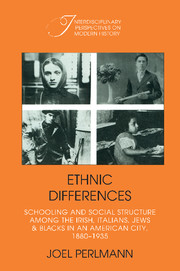 Ethnic Differences
Ethnic Differences Appendix: The Research Design, the Data Collection, and the Use of Regression Analyses
Published online by Cambridge University Press: 05 October 2010
Summary
The purpose of this Appendix is to provide enough information to enable the reader to understand how the samples were gathered, coded, and processed and how regression analyses were used to construct the tables in the text. I have discussed all these issues, particularly the research design and data collection, in several other contexts. Consequently, the discussion here is not meant to be exhaustive.
This Appendix is divided into nine sections:
An overview of the research design
Selecting the samples
Obtaining additional information on family background
Obtaining information on schooling
Obtaining information on the male sample member's career
The coding and classification of occupations
The organization of the data collection and processing
The use of regression analysis
Assessing contextual effects: the case of the Italians
An overview of the research design
In its essentials, the research design is simple. Manuscript schedules were available from censuses taken by the federal government in 1880 and 1900 and by the state of Rhode Island in 1915 and 1925. Male sample members were drawn from these manuscripts and then traced in their school records. Samples of girls were gathered in the same way from the sources for 1880 and 1915. Finally, all male sample members were traced one decade forward in time in city directories, which indicated their occupations. They were traced in the directories for Providence as well as those for nearby towns.
Information
- Type
- Chapter
- Information
- Ethnic DifferencesSchooling and Social Structure among the Irish, Italians, Jews, and Blacks in an American City, 1880–1935, pp. 220 - 251Publisher: Cambridge University PressPrint publication year: 1988